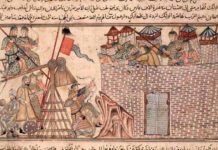Nationalism has many definitions, but it is broadly the increasing desire of a people to determine their identity, lifestyle and destiny for themselves. For the Netherland Indies, controlled by Dutch colonists since the 1800s, nationalism, which began circa 1900, would finally lead give rise to a new nation-state, Indonesia.
Indonesia from the 1900 to the 1940s
During this period, there was a growing consciousness of a national concern, seen by the formation of several organizations taking the whole colony as their organizational frame, as opposed to groups with smaller perspectives, such as ethnic or local issues. Some such organizations include:
- National Indies Party, founded in 1912 by Javanese, Eurasian and Dutch men
- Partai Komunis Indonesia, founded in 1921 by communists
- Congress of Indonesian Women, a federation of women’s organizations founded in 1928
- Partai Nasional Indonesia, founded in 1929 by Sukarno
Sukarno, in particular, was an important figure. His eloquence at political rallies helped to spread the message of freedom across a diverse Indonesia, galvanizing them to set aside differences, unite, and oppose colonial rule. Sukarno would eventually become President of Indonesia upon their independence in 1945.
However, Dutch responses to Indonesian nationalism were not encouraging, and they reacted by tightening laws and getting rid of the leading political activists through jail or exile. Sukarno himself was exiled in 1934.
It was the Japanese Occupation during World War II that radically boosted Indonesia’s case for independence.
Effects of Japanese Occupation on Indonesian Nationalism
Similar to rest of Southeast Asia, the Japanese occupation fuelled nationalism, as European dominance was increasingly questioned and rejected. Some positive effects specific to Indonesia include:
The Japanese continued to use Indonesian as the language of administration, rather than enforcing the use of Japanese, helping unity upon independence.
Locals were empowered through being given leadership opportunities which they were previously denied under Dutch rule.
The military training was given to the Indonesians, originally to support the Japanese war machine, would come in useful during the conflicts from 1946 to 1949.
However, there were also some negative aspects which would hamper the nationalistic cause.
This included the taxing of resources to fuel the war effort. This is marked in the shortage of food and clothing, and also the romusha program, where it was mandatory for fit males to provide free labour to support the war effort.
Japan also split Indonesia it into three portions for easier administration, to be controlled by different sections of the Japanese armed forces. This had the effect of breaking unifying processes of Batavia as Indonesia’s centre, which the Dutch had emplaced over the years, and compromising the idea of Indonesia as a single nation.
It was the concentration of men who were committed to the idea of Indonesia in Java (notably Sukarno and Hatta), and their seizing of power from there in 1945 upon Japanese surrender, that enabled Indonesia to emerge as a single colonial state after the war rather than three different ones.
Challenges upon Indonesia’s Declaration of Independence
Indonesian nationalism had carried the country to a point in history that was exciting and optimistic, yet also chaotic and dangerous, and the new nation’s problems were just beginning. Dutch rejection of their declaration of independence would bring about a tumultuous period of armed conflicts and negotiations from 1946 to 1949, before the final recognition of their independence by the United Nations.
There were also many internal problems which had to be addressed. This included the question of what political structure to adopt, and the role of Islam in politics. An economy which had just been through war and thus would not be able to support the country’s needs, as well as a still ambiguous cultural idea of what Indonesian national identity was exactly would be issues that Indonesia would need to address.
Bibliography:
- A Short History of South-east Asia (3rd edition) by Peter Church (published 2003)
- The Emergence of Modern Southeast Asia Edited by Normal G. Owen et al. (published 2005)








